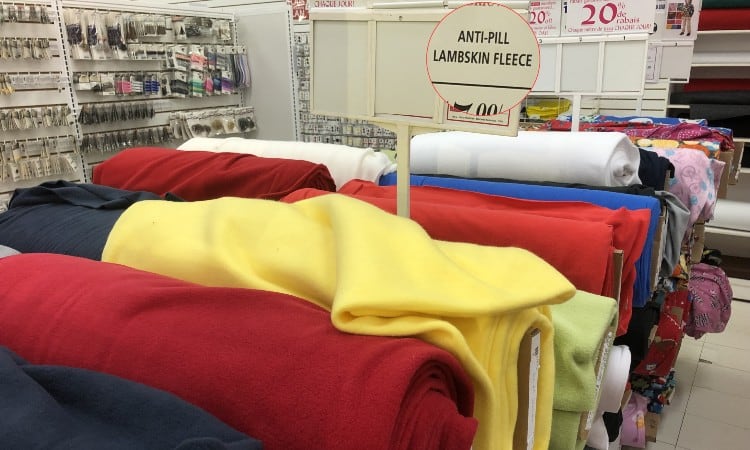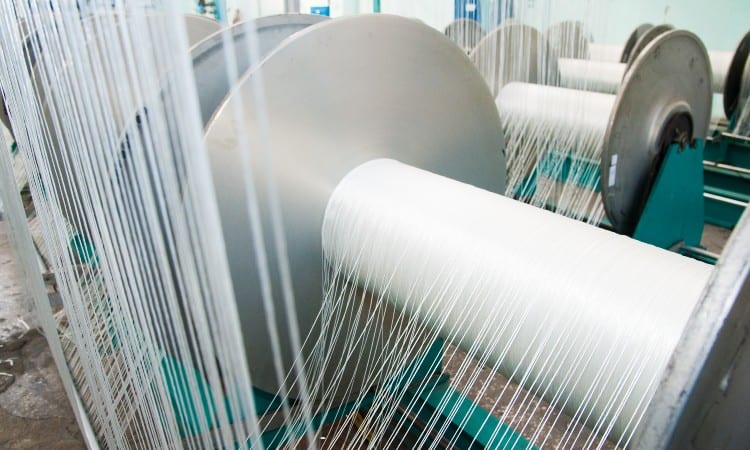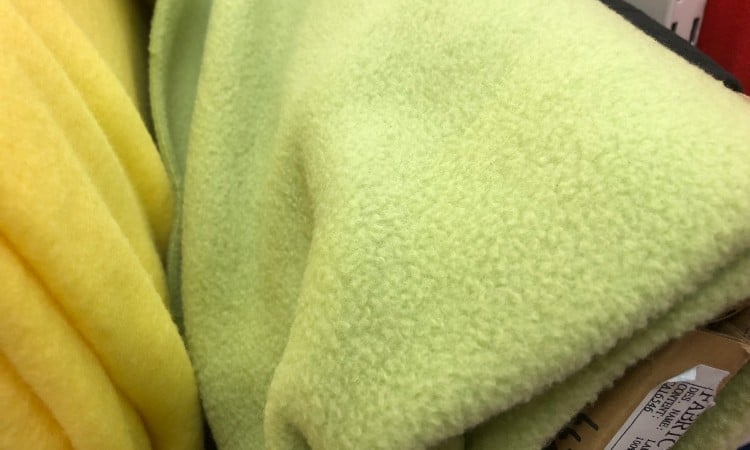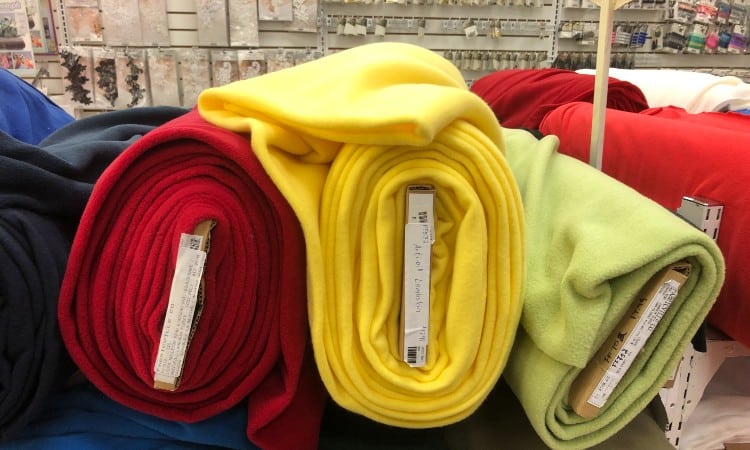Polar fleece. Microfleece. Sherpa fleece. Plush fleece. You need fleece fabric for a project but aren’t sure which to use. With so many different types of fleece, the decision can seem overwhelming. That’s why I’ve created this guide to the different types of fleece fabric so that you can choose the right fleece fabric for your project.
Fleece is the general term for a warm and soft fabric usually worn in winter. It can be used as a lining or as a stand-alone fabric. There are 11 different types of fleece fabric:
- Anti Pill
- Blizzard
- Bonded
- Cotton
- French Terry
- Microfleece
- Plush
- Polar
- Polyester
- Sherpa
- Spandex/Lycra
These types of fleece are all unique from each other and have different uses as a result. I’ll touch on each one of these types of fleece in this article so that you’ll have a better understanding of their differences. Hopefully, it will help make your decision easier when choosing fleece for your project.

What is Fleece Fabric?
Before we get into the different types of fleece, it’s necessary to talk about what fleece is in a more general sense. Sometimes there’s confusion because when we think of fleece, we tend to think of the fur on wool-bearing animals.
It’s true that fleece is a term for sheep’s wool, for example. But when it comes to the fabric, fleece has a different meaning. The term fleece describes fabric that is soft and fuzzy to the touch (just like fur). But rather than being made from the fur itself, it is made from other materials and designed to mimic the look and feel of animal fleece.
Let’s take a closer look at exactly what fleece fabric is.
How is Fleece Made?

Most types of fleece are man-made fabrics made from synthetic materials. Essentially, any type of synthetic fabric is a form of plastic. Plastics are made by combining different chemicals and processing them to give them characteristics depending on how they will be used.
The raw materials used to make fabric are in a liquid form. The materials are then heated up to combine them. After being combined, the liquid cools to a syrupy consistency and is poured through a disc with holes called a spinneret. After going through the spinneret, the liquid hardens to form strings.
The strings are woven into yarn and the yarns are knitted together to form the fabric. In the case of fleece, the fabric is put through a machine called a napper, where it is brushed to give it more texture. Then, the fibers are cut in a shearing machine, which makes them softer as well. If necessary for certain types of fleece, the fabric is then coated to make it more waterproof.
Is Fleece Natural or Synthetic?
Fleece is one of the best man-made fabrics. But since it is man-made, that means that it is synthetic. Most types of fleece are made with polyester fibers, and polyester is one of the most common and versatile synthetic materials used for fabric.
However, some types of fleece are natural, such as cotton fleece. Cotton fleece can be made with 100% cotton or be a blend of polyester and cotton. But for the most part, fleece is a synthetic fabric, so it is so durable and versatile.
General Characteristics of Fleece

There are many characteristics of fleece that make it an ideal fabric for cold weather. It’s these same qualities that make fleece such a well-loved and popular fabric.
One of the best qualities of fleece is that it is a good insulator, which is why it will keep you warm better than other fabrics. It also repels water naturally, although it is still sometimes treated with a waterproofing chemical to increase its resistance to water.
One reason that it is water-resistant is that it is made from plastic fibers. But another reason is due to the thick texture of the fabric. And since it naturally repels water, it also dries fairly quickly. That’s exactly what you want for activewear that you wear in the snow and other winter weather conditions.
Other benefits of wearing fleece are that it is breathable and machine washable. And since the fabric isn’t made from animal fur, fleece is vegan if that is important to you. It is also hypoallergenic compared to wool, which means that it won’t be as itchy or cause irritation. That’s why it’s a better choice for people with a wool allergy.
Of course, there are a few downsides to fleece fabric. For example, fleece can create a lot of static due to its texture. It is also prone to pilling and can’t be exposed to high temperatures. Since fleece is made from plastic, high temperatures can cause the fibers to melt.
Remember that these are just general characteristics of fleece fabric. But the downsides to fleece have led to new variations of it. Different types of fleece have slight differences among them to make them more durable or useful for certain types of clothing. So without further adieu, here are the different types of fleece.
What are the Different Types of Fleece?

1. Anti Pill Fleece
 We mentioned that one of the downsides of fleece is that it can pill up. These pills are caused by the fibers rubbing together due to static electricity or abrasion during the wash. The fibers become knotted up and form little balls on the fabric’s surface, known as pills.
We mentioned that one of the downsides of fleece is that it can pill up. These pills are caused by the fibers rubbing together due to static electricity or abrasion during the wash. The fibers become knotted up and form little balls on the fabric’s surface, known as pills.
The tendency of fleece to pill up led to the creation of anti-pill fleece. This type of fleece resists pilling due to being worn and washed. How it works is that the fleece was treated with a chemical that helps to prevent the fibers from getting tangled, reducing pilling.
While anti-pill fleece may not stay pill-free forever, it will resist pilling longer than other types of fleece. Clothing made with anti-pill fleece will look and feel better longer than fleece that isn’t anti-pill. Anti-pill fleece is great for apparel that gets worn and frequently washed, such as sleepwear and pajamas.
2. Blizzard Fleece
 Blizzard fleece is a type of fleece fabric that is smoother and softer than anti-pill fleece, meaning that it will feel better against your skin. It is also a bit denser and thicker, meaning that blizzard fleece is warmer as well. This type of fleece is ideal for blankets, scarves, and gloves that will keep areas of your body warm that other articles of clothing won’t.
Blizzard fleece is typically made out of 100% polyester fibers. That means that it is generally very durable and will last a long time. However, it isn’t treated the way that anti-pill fleece is. That means that blizzard fleece is more prone to pilling.
Blizzard fleece is a type of fleece fabric that is smoother and softer than anti-pill fleece, meaning that it will feel better against your skin. It is also a bit denser and thicker, meaning that blizzard fleece is warmer as well. This type of fleece is ideal for blankets, scarves, and gloves that will keep areas of your body warm that other articles of clothing won’t.
Blizzard fleece is typically made out of 100% polyester fibers. That means that it is generally very durable and will last a long time. However, it isn’t treated the way that anti-pill fleece is. That means that blizzard fleece is more prone to pilling.
3. Bonded Fleece
 The term bonded fleece means that the fleece is bonded to something else. For clothing like jackets and outerwear, fleece is used as a lining and bonded to a heavier fabric. This makes the clothing warm but resistant to other elements like the wind in harsher climates where fleece alone won’t work.
Bonded fleece could also refer to two pieces of fleece that are bonded together to create a double-sided effect. You might find this type of fleece being used for a plaid shirt. Or, this type of fleece might be used for outerwear that doesn’t necessarily need to be as warm and heavy as a jacket.
The term bonded fleece means that the fleece is bonded to something else. For clothing like jackets and outerwear, fleece is used as a lining and bonded to a heavier fabric. This makes the clothing warm but resistant to other elements like the wind in harsher climates where fleece alone won’t work.
Bonded fleece could also refer to two pieces of fleece that are bonded together to create a double-sided effect. You might find this type of fleece being used for a plaid shirt. Or, this type of fleece might be used for outerwear that doesn’t necessarily need to be as warm and heavy as a jacket.
It’s great to use as a light outer layer for cool days.
4. Cotton Fleece
 While most types of fleece on this list are synthetic and made from polyester, cotton fleece is just as it sounds: made from cotton. The basic method of producing cotton fleece is the same as fleece made with synthetic materials. The fibers are woven into yards, knitted into fabric, and then brushed. The major difference is that cotton fleece is made with natural fibers instead of synthetic ones.
While most types of fleece on this list are synthetic and made from polyester, cotton fleece is just as it sounds: made from cotton. The basic method of producing cotton fleece is the same as fleece made with synthetic materials. The fibers are woven into yards, knitted into fabric, and then brushed. The major difference is that cotton fleece is made with natural fibers instead of synthetic ones.
The other major difference betweencotton fleece and fleece made from synthetic materials is that cotton fleece is more breathable. Certain types of fleece can feel stuffy, but cotton fleece will do a better job of circulating air while still keeping you warm. However, cotton tends to shrink, which is something to consider when debating between different types of fleece fabric.
5. French Terry Fleece
 This type of fleece varies greatly from the other types of fleece on this list. French terry fleece is thinner instead of thick, so it doesn’t have quite the same uses. You might see this fleece used for sweatshirts, shorts, and light hoodies that you might wear in fall, early spring, or even summer as opposed to winter. French terry is also great for loungewear that you would wear to keep you cozy and comfortable inside your home.
French terry fleece isn’t fluffy like other types of fleece because it is not brushed. It also has a looser weave, so it is more breathable and will “give” more when worn. In general, fleece doesn’t stretch much, but French terry is more stretchy. However, the downside is that since French terry lacks the texture of other types of fleece, it is not as warm.
This type of fleece varies greatly from the other types of fleece on this list. French terry fleece is thinner instead of thick, so it doesn’t have quite the same uses. You might see this fleece used for sweatshirts, shorts, and light hoodies that you might wear in fall, early spring, or even summer as opposed to winter. French terry is also great for loungewear that you would wear to keep you cozy and comfortable inside your home.
French terry fleece isn’t fluffy like other types of fleece because it is not brushed. It also has a looser weave, so it is more breathable and will “give” more when worn. In general, fleece doesn’t stretch much, but French terry is more stretchy. However, the downside is that since French terry lacks the texture of other types of fleece, it is not as warm.
6. Microfleece
 Microfleece is the thinnest and most lightweight type of fleece, weighing less than 200 grams per square meter. Because of this, microfleece is comfortable to wear since it doesn’t feel as if it weighs you down. You can use it as a layer either under or clothes or over them because it has more flexibility.
Microfleece isn’t as insulating as other types of fleece, which also means it isn’t as warm. However, it is more breathable, which is why it is used to make lightweight outerwear like shirts and jackets. It can also be used to make activewear, bathrobes, and throw blankets.
Microfleece is the thinnest and most lightweight type of fleece, weighing less than 200 grams per square meter. Because of this, microfleece is comfortable to wear since it doesn’t feel as if it weighs you down. You can use it as a layer either under or clothes or over them because it has more flexibility.
Microfleece isn’t as insulating as other types of fleece, which also means it isn’t as warm. However, it is more breathable, which is why it is used to make lightweight outerwear like shirts and jackets. It can also be used to make activewear, bathrobes, and throw blankets.
7. Plush Fleece
 Plush fleece is fleece with a super-soft and luxurious feel typically used to make heavy throw blankets. This type of fleece feels the most like fur compared to the other types of fleece and is loved for its softness, comfort, and warmth. However, plush fleece isn’t ideal for making clothing due to how heavy it is.
Plush fleece is fleece with a super-soft and luxurious feel typically used to make heavy throw blankets. This type of fleece feels the most like fur compared to the other types of fleece and is loved for its softness, comfort, and warmth. However, plush fleece isn’t ideal for making clothing due to how heavy it is.
The downside to this type of fleece is that it tends to be more expensive than other types of fleece due to the thickness and texture. Plush fleece also tends to shed, so it is important to properly finish the ends when using it for a sewing project. One of the most popular projects to use plush fleece for is baby blankets.
8. Polar Fleece
 Polar fleece is one of the most durable types of fleece. It is also one of the most widely used types of fleece for clothing and apparel. If you see an article of clothing labeled simply as “fleece,” it is more than likely made from polar fleece.
Polar fleece is incredibly warm and comes in different thicknesses. But the thicker it is, the stiffer it is as well. However, polar fleece repels water well and dries quickly if it does get soaking wet. Even if it does become wet, it will still keep you warm. This is one of the best types of fleece to wear in cold and sometimes wet wintry weather.
Polar fleece is one of the most durable types of fleece. It is also one of the most widely used types of fleece for clothing and apparel. If you see an article of clothing labeled simply as “fleece,” it is more than likely made from polar fleece.
Polar fleece is incredibly warm and comes in different thicknesses. But the thicker it is, the stiffer it is as well. However, polar fleece repels water well and dries quickly if it does get soaking wet. Even if it does become wet, it will still keep you warm. This is one of the best types of fleece to wear in cold and sometimes wet wintry weather.
9. Polyester Fleece
 Polyester fleece is a general term used to refer to fleece made out of polyester. This is the original type of fleece that was invented to mimic wool. Although it is synthetic, it is more favorable than fleece made out of cotton because it is more durable and won’t shrink when it is washed. The polyester fibers are also what makes fleece so quick-drying and resistant to moisture.
Polyester fleece is a general term used to refer to fleece made out of polyester. This is the original type of fleece that was invented to mimic wool. Although it is synthetic, it is more favorable than fleece made out of cotton because it is more durable and won’t shrink when it is washed. The polyester fibers are also what makes fleece so quick-drying and resistant to moisture.
Most of the types of fleece on this list are made out of polyester, but the uniqueness in how they are woven or brushed makes them different from each other. In general, polyester fleece is used to make jackets, hats, mittens, scarves, and other types of clothing.
10. Sherpa Fleece
 Sherpa is the closest type of fleece to sheep’s wool in both appearance and texture. The texture of sherpa fleece is different on each side. One side is smooth, while the other side looks like wool. Sherpa also has more stretch to it than other types of fleece fabric.
Sherpa is the closest type of fleece to sheep’s wool in both appearance and texture. The texture of sherpa fleece is different on each side. One side is smooth, while the other side looks like wool. Sherpa also has more stretch to it than other types of fleece fabric.
Sherpa fleece is warmer and more insulating than most types of fleece. You will more than likely see this type of fleece used as a lining for jackets or blankets. Sherpa can be used to line all kinds of materials, even denim and corduroy, to make these heavy materials warmer.
11. Spandex/Lycra Fleece
The terms spandex and lycra are different names for the same stretch fabric, so they are often used interchangeably. With that being said, spandex/lycra fleece is a type of stretchy fleece used to make fleece garments have a more fitted look.
This type of fleece is primarily made from cotton with a small percentage of spandex or lycra blended in. You may also find cold-weather athletic and performance wear made from spandex/lycra fleece. It will keep you warm but also move with you when running or exercising outdoors in colder weather.
What is the Softest Type of Fleece?
The softest types of fleece are plush fleece, microfleece, and sherpa fleece. For a fabric that you wear close to your skin, these will be the most comfortable in addition to keeping you warm. That’s why all of these varieties of fleece are typically used to make blankets. But since plush fleece is very heavy and microfleece isn’t as warm, you will likely see sherpa used as a lining for hats, scarves, and jackets.
What is the Difference Between Fleece and Plush Fleece?
Fleece fabric, in general, can be made out of either cotton or polyester, but plush fleece is usually made out of 100% polyester. But as far as texture goes, plush fleece is a lot softer and less scratchy than other fleece fabrics.
This is because fabrics that are referred to as plush fleece are brushed on both sides of the fabric instead of just one side. And instead of feeling similar to wool, plush fleece feels more like fur, which is why it is so soft and warm.
What is the Difference Between Fleece and Microfleece?
The terms fleece and microfleece are often used to refer to the same type of fabric. However, microfleece refers to a certain weight of fleece fabric, so not all fleece is microfleece. It is called microfleece because it is the thinnest and most lightweight of all of the fleece fabrics.
Microfleece refers to fleece fabric that weighs less than 200 grams per square meter. The next level of thickness for fleece is mid-weight fleece, with a weight of 200-300 grams per square meter. Lastly, heavy-weight fleece has a weight of 300 grams per square meter or greater.
How to Choose Fleece

If you’re looking at fabrics, then you likely already have a project in mind. You need to consider what you’re trying to make to decide on a fabric. In the types of fleece mentioned above, some are better for specific things than others.
For example, sherpa fleece is better used as a lining or for blankets. It isn’t necessarily a good choice as the main fabric for shirts and hats. If you’re making a shirt, jacket, hat, or gloves, then polar fleece or microfleece or better options.
You’ll also want to consider the characteristics of different types of fleece. You may have to decide between cotton or polyester fleece, depending on if you want a natural fabric or synthetic fabric. You should also keep in mind the level of warmth that different types of fleece offer, as well as whether or not the fleece is anti-pill or bonded.
How to Sew Fleece
The thickness and texture of fleece make it more difficult to sew with than other fabrics. Here are some tips that will make sewing with fleece a bit easier:
- Use a longer stitch (8-10 inches) to keep the fabric from becoming distorted.
- Make sure that the nap and texture are laid out in the same direction when using multiple pieces of fabric.
- Match the thread fiber to the fabric fiber (e.g. polyester thread for polyester fleece).
- Use a ballpoint needle so that the fabric isn’t pierced, which can cause holes in the fabric and shorten its life.
- Skip heavy embellishments because they can cause the fabric to sag.
How to Care for Fleece
Since fleece is most often a synthetic fiber and has a unique texture, taking care of it properly is important for ensuring that the fleece remains soft and stays in good shape. Follow these recommendations when washing fleece fabrics:
- Heat can melt or damage the fibers. Wash in cold water to keep this from happening.
- Use the gentle cycle. This will lower abrasion to keep fleece from pilling and maintain the soft texture.
- Do not use bleach or fabric softener as this can ruin the softness of the fibers.
- Avoid excessive heat when drying to keep from damaging the fibers. Air-drying fleece is preferred, but you can also tumble dry on low heat.
- An iron gets hotter than even your dryer, so avoid ironing fleece. This is the best way to damage it.
Conclusion
I hope this guide to different fleece fabrics will make your decision easier when it is time to choose one for your project. The biggest differences between fleece fabrics are warmth and texture. You should always keep in mind the type of project you are working on and the characteristics of different types of fleece when making your decision. If you enjoyed this article, share it with others and leave a comment. Thanks for reading!